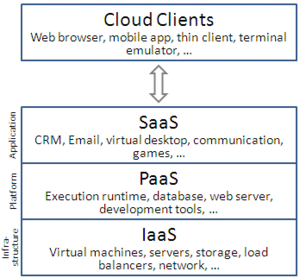
Cloud computing has had an irreversible impact on how IP telephony and other network services are delivered. In this article, we look at the three most common cloud service models and how they are used to deliver telecommunications and other services to connected businesses. By adding cloud-based services to your arsenal of offerings, you can deliver more value to your customers by proposing a wider range of services to them.
What is the cloud?
Cloud computing is the on-demand availability of computer system resources, without the direct active management of the computer system by the user. Put another way, it is a platform that can be used to provision virtual computer systems with various CPU, memory, and storage characteristics. These virtual computer systems are then available to be used over the network. For example, you can log in to a cloud computing platform, such as Amazon Web Services (AWS) or Google Compute Engine, and create a virtual server with the characteristics of your choice (CPU power, memory, storage space), and run an operating system on it and any other network services you like.
The result is something similar to virtualization but on a much broader scale, and with much more profound implications. The great advantage here is that you can have all of these computer resources available to you, and accessible from anywhere, provided you have an internet connection. The actual physical location of these resources doesn’t really matter, and you may never really know where they are. They may even be distributed over various datacenters across multiple countries or continents. It is for this reason we say that the service is provided from, or exists on, “the cloud.”
Cloud service models
Cloud computing providers offer their services using various service models, three of which are the most prominent. These are Software as a Service (SaaS), Platform as a Service (PaaS), and Infrastructure as a Service (IaaS). These models provide different levels of service to cloud clients and are arranged in a layered format as in the following diagram.

IaaS – This model refers to online services that supply computing infrastructure to the client. Provisioning an online virtual server is an instance of IaaS. IaaS platforms essentially provide you with the computing infrastructure to create and run your own servers and services as you see fit. You install the software, you configure it and you deliver the services to your end users. In general, this is considered a lower level of service. This is not an indication of quality, but simply means that only the computing infrastructure is provided. Any additional services that are to function must be provisioned, set up, and configured by the cloud user. Examples of IaaS offerings include Amazon Web Services, Microsoft Azure, and Cisco Metacloud.
PaaS – This model delivers a platform on which users can develop, run, and manage their own applications without the complexity of building or maintaining computer systems. This is considered to be one level higher than IaaS, as users are not required to deal with infrastructure, such as resources, CPU, memory, or operating systems. Users of PaaS are primarily organizations that want to develop their own online services without the hassle of dealing with infrastructure. Examples of PaaS services include Google App Engine and AWS Elastic Beanstalk.
SaaS – This model gives users access to end-user software over the network. Cloud providers manage the infrastructure and platforms that use the software. This is one level higher than PaaS, because end users directly use the software applications being provided. Examples of SaaS include Dropbox, Microsoft Office 365, and cloud-based phone service providers. Click here for a full list of TeleDynamics’ cloud communications partners.
The cloud for voice services
The SaaS service model has been used by VoIP providers for several years now. A cloud-based unified communications system can be of great advantage to most businesses. Specifically, benefits include:
- All the benefits of a SIP server without having to maintain it in your own datacenter. This way you save on infrastructure costs such as power redundancy, cooling systems, and rack space.
- Increased time and cost savings concerning the patching and upgrading of the SIP server software, since these services are the responsibility of the provider, and are usually included in the subscription cost of the cloud VoIP service.
- Only SIP endpoints are required on the customer premises, so no additional hardware is needed.
- Dynamic upsizing or downsizing of your system depending on the needs of your business.
- Everything is managed from a single centralized location, regardless of how many branch offices you may have.
Individual vendors can also choose to use IaaS or PaaS deployment models to develop their own VoIP services and offer them, in turn, to their own customer base.
So far, we’ve examined the various service models available for the cloud as well as their benefits for VoIP systems. However, we have only addressed cloud service models that exist on the internet. Varying deployment models allow for the cloud to exist on private infrastructure as well, but this will be addressed in a future article.
Conclusion
Cloud-based VoIP services allow communications applications to be delivered to businesses no matter where they are or how many branch offices they have, provided they have an internet connection. The three most common cloud service models are IaaS, PaaS and SaaS.
You may also like:
How to choose a cloud-based phone service for your business
How virtualization revolutionizes VoIP deployment
Cloud and UC: Is your telephone system on board?
View list of TeleDynamics’ featured cloud partners









Comments